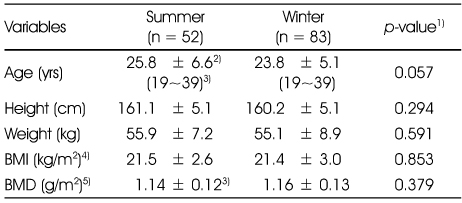Articles
- Page Path
- HOME > Korean J Community Nutr > Volume 19(3); 2014 > Article
-
Research Article
- Seasonal Differences in Outdoor Activity Time and Serum 25-(OH) Vitamin D Status of Korean Young Women
- Jin-Sook Yoon, Min-Kyoung Song
-
Korean Journal of Community Nutrition 2014;19(3):231-240.
DOI: https://doi.org/10.5720/kjcn.2014.19.3.231
Published online: June 30, 2014
Department of Food and Nutrition, Keimyung University, Daegu, Korea.
- Corresponding author: Jin-Sook Yoon. Department of Food and Nutrition, Keimyung University, 1000 Shindang-dong, Dalseo-gu, Daegu, Korea. Tel: (053) 580-5873, Fax: (053) 580-5885, jsook@kmu.ac.kr
Copyright © 2014 The Korean Society of Community Nutrition
This is an Open-Access article distributed under the terms of the Creative Commons Attribution Non-Commercial License (http://creativecommons.org/licenses/by-nc/3.0/) which permits unrestricted non-commercial use, distribution, and reproduction in any medium, provided the original work is properly cited.
- 1,111 Views
- 0 Download
- 3 Crossref
Figure & Data
REFERENCES
Citations

- Vitamin D intake, Outdoor Activity Time and Serum 25-OH Vitamin D Concentrations of Korean Postmenopausal Women by Season and by Age
Jin-Sook Yoon, Min-Kyoung Song
Korean Journal of Community Nutrition.2015; 20(2): 120. CrossRef - The relationship between Physical Growth and Major Sources of Serum Vitamin D among Hospitalized Children of Changwon City
Haeyoung Kang, Eunsil Her, Kyung-Hea Lee
Korean Journal of Community Nutrition.2015; 20(3): 197. CrossRef - Association between serum vitamin D and depressive symptoms among female workers in the manufacturing industry
Soon Il Kwon, Jun Seok Son, Young Ouk Kim, Chang Ho Chae, Ja Hyun Kim, Chan Woo Kim, Hyoung Ouk Park, Jun Ho Lee, Jun Ick Jung
Annals of Occupational and Environmental Medicine.2015;[Epub] CrossRef

Fig. 1
Physical characteristics of the study subjects by season
1) Independent sample t-test
2) Mean ± SD
3) Range of values (minimum~maximum)
4) Body mass index
5) Bone mineral density
Bone health status of the study subjects by season
1) T-score ≥ -1.0
2) n (%)
3) T-score < -1.0
Daily energy and nutrient intake of the study subjects by season
1) %KDRIs mean % EER (Estimated energy requirement) for energy; %AI(Adequate intake) for Na, K, vitamin D, % RNI (Recommended nutrient intake) for other nutrients
2) Independent sample t-test
3) Mean ± SD
4) Range of values (minimum~maximum)
Distribution of the level of vitamin D intake of the study subjects by 24hr recall method
1) n (%)
The intakes of vitamin D estimated from the food frequency method
1) Independent Sample t-test
2) Unit: µg/day
3) Mean ± SD
4) Range of values (minimum~maximum)
Time spent on outdoor activities by season
1) Independent sample t-test
2) Unit: minutes
3) Mean ± SD
4) Range of values (minimum~maximum)
Serum levels of 25-(OH) vitamin D by season
1) Independent sample t-test
2) Mean ± SD
3) Range of values (minimum~maximum)
Distribution of serum 25-(OH) vitamin D level
1) n (%)
Correlation coefficients between serum 25-(OH) vitamin D and the results of physiological characteristics, BMD, hours of outdoor activity, vitamin D intake
*: p < 0.05, **: p < 0.01
1) Independent sample t-test 2) Mean ± SD 3) Range of values (minimum~maximum) 4) Body mass index 5) Bone mineral density
1) T-score ≥ -1.0 2) n (%) 3) T-score < -1.0
1) %KDRIs mean % EER (Estimated energy requirement) for energy; %AI(Adequate intake) for Na, K, vitamin D, % RNI (Recommended nutrient intake) for other nutrients 2) Independent sample t-test 3) Mean ± SD 4) Range of values (minimum~maximum)
1) n (%)
1) Independent Sample t-test 2) Unit: µg/day 3) Mean ± SD 4) Range of values (minimum~maximum)
1) Independent sample t-test 2) Unit: minutes 3) Mean ± SD 4) Range of values (minimum~maximum)
1) Independent sample t-test 2) Mean ± SD 3) Range of values (minimum~maximum)
1) n (%)
*: p < 0.05, **: p < 0.01

 KSCN
KSCN










 Cite
Cite


